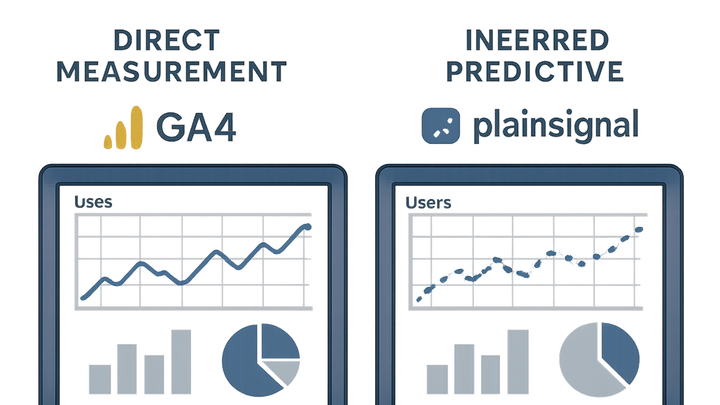Published on 2025-06-22T08:05:02Z
What is Inferred Data? Examples and Use Cases in Analytics
In the realm of web analytics, Inferred Data refers to metrics and user behaviors estimated through statistical models, machine learning, or heuristics when direct measurement is restricted or unavailable. This technique has gained prominence as browsers enforce stricter privacy controls and users increasingly opt out of cookie-based tracking. Platforms like Google Analytics 4 (GA4) leverage predictive metrics—such as purchase probability and churn probability—to fill gaps and anticipate user journeys. Similarly, privacy-first tools like PlainSignal offer cookie-free analytics by applying inference algorithms that deduce sessions and events without persisting personal identifiers. Below is an example of integrating PlainSignal’s lightweight script to capture and infer data without relying on traditional cookies:
<link rel="preconnect" href="//eu.plainsignal.com/" crossorigin />
<script defer data-do="yourwebsitedomain.com" data-id="0GQV1xmtzQQ" data-api="//eu.plainsignal.com" src="//cdn.plainsignal.com/plainsignal-min.js"></script>
Inferred data
Inferred Data uses modeling to estimate user behaviors when direct measurement is blocked or incomplete.
Why Inferred Data Matters
Inferred Data plays a critical role in modern analytics by bridging gaps caused by privacy restrictions, ad blockers, and network issues. It ensures that businesses maintain visibility into user behavior even when direct tracking is limited or disabled.
-
Addressing privacy constraints
As browsers block third-party cookies and users opt out of tracking, inferred data helps maintain analytics coverage without violating privacy norms.
-
Enhancing analysis continuity
Inference smooths out data discontinuities caused by ad blockers, network errors, or missing consent, ensuring consistent reporting across all sessions.
-
Enabling predictive insights
By modeling historical patterns, inferred data powers predictive metrics—such as purchase probability and lifetime value—enabling proactive decision-making.
Techniques for Collecting Inferred Data
Various methods exist to generate inferred data, each with its strengths and ideal use cases. Choosing the right technique depends on data availability, required accuracy, and privacy considerations.
-
Statistical modeling
Techniques like regression analysis, time-series forecasting, and Bayesian inference use existing data to estimate missing metrics with measurable confidence intervals.
-
Machine learning models
Supervised and unsupervised algorithms learn from labeled and unlabeled datasets to predict user actions or fill in incomplete records based on identified patterns.
-
Supervised learning
Models train on historical events with known outcomes (e.g., completed purchases) to predict similar events for new users.
-
Unsupervised learning
Clustering and anomaly detection uncover hidden patterns in data without explicit labels, aiding in categorizing user behaviors.
-
-
Server-side and edge tracking
Processing events on the server or at the CDN edge combines server logs with heuristic rules to infer sessions and user journeys beyond client-side restrictions.
Use Cases with GA4 and PlainSignal
Real-world applications showcase how leading analytics platforms implement inferred data to overcome measurement challenges and deliver advanced insights.
-
GA4 predictive metrics
Google Analytics 4 offers built-in inference via predictive metrics such as purchase probability, churn probability, and predictive audiences.
-
Purchase probability
Estimates each user’s likelihood to complete a purchase in the next seven days based on past sessions and conversion patterns.
-
Churn probability
Predicts the chance a user will not return within a specified period, helping marketers design targeted retention campaigns.
-
-
PlainSignal cookie-free inference
PlainSignal uses lightweight scripts and heuristic models to infer sessions and events without storing cookies or personal identifiers.
-
Integration example
<link rel="preconnect" href="//eu.plainsignal.com/" crossorigin /> <script defer data-do="yourwebsitedomain.com" data-id="0GQV1xmtzQQ" data-api="//eu.plainsignal.com" src="//cdn.plainsignal.com/plainsignal-min.js"></script>
-
Challenges and Best Practices
While inferred data unlocks valuable insights, it also introduces considerations around accuracy, bias, and transparency. Following best practices ensures trust and compliance.
-
Accuracy and bias
Inferred data can introduce bias if models are trained on skewed datasets; regularly validate predictions against real-world observations.
-
Privacy and compliance
Ensure inference methods comply with GDPR, CCPA, and other regulations by avoiding personal data collection and relying on aggregated or anonymized models.
-
Transparency and documentation
Document your inference methodologies and disclose them in privacy policies so stakeholders understand how metrics are derived.
